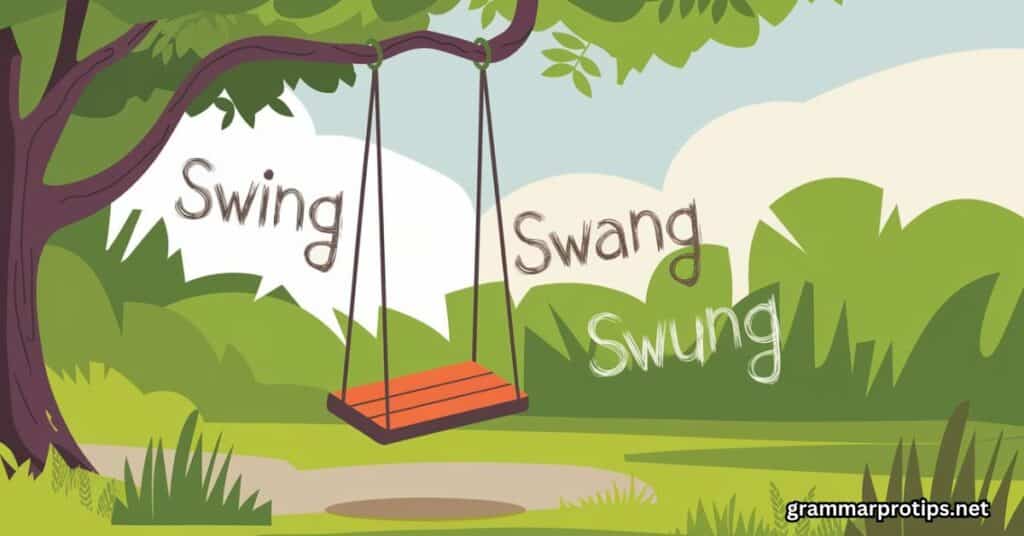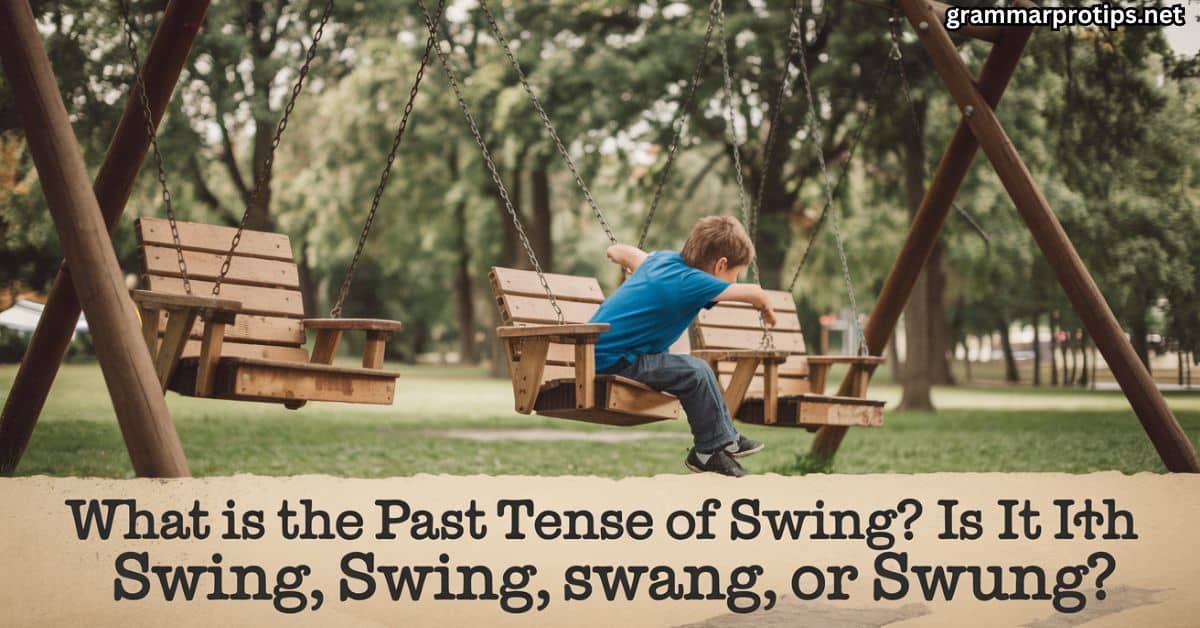The English language is full of quirky rules and exceptions, and one of the most frequently debated topics revolves around the past tense of swing. You’ve probably found yourself asking: Is the past tense of swing “swang” or “swung”? Or perhaps, you’ve heard someone use “swang” and wondered if they were simply making a mistake. Well, let’s clear things up once and for all.
In this article, we’ll dive deep into this topic, explain the swing past tense, and provide plenty of examples to illustrate how swing, swang, swung are used correctly in different contexts.
You’ll also find some comparisons with other irregular verbs, making this a handy reference for English learners and enthusiasts alike.
The Basics of Verb Tenses
To get started, it’s important to understand how verb tenses work in English. Verb tenses show when an action occurs: in the present, past, or future.
The past tense is used to describe actions that happened in the past, while the past participle is used with helping verbs like “have” or “had” to create compound tenses (like the present perfect).
For many English verbs, the past tense is formed by adding -ed to the base verb (like walk becoming walked). But irregular verbs like swing don’t follow this simple rule, which can lead to some confusion.
The Past Tense of Swing: Swang or Swung?
When it comes to the past tense of swing, it’s not a matter of personal preference; it’s all about the rules of grammar. While you might hear people say “swang,” the correct past tense form of swing is actually swung.
Swung: The Correct Past Tense of Swing

Let’s start with swung, the correct past tense and past participle of swing. Here’s how to use it properly in sentences:
- I swung the bat so hard that I hit a home run.
- They swung from the trees during their jungle adventure.
In both of these examples, swung refers to an action that occurred in the past. It’s the form you’ll use in all standard contexts. The word “swung” is part of the past tense of swing in English, and it is consistently used in both written and spoken language.
Example Email:
Subject: Meeting Reschedule – Action Taken
Hi Sarah,
I just wanted to let you know that I swung by the office earlier to pick up the reports. Unfortunately, I wasn’t able to meet with you as planned because of the last-minute schedule changes. I’ve rescheduled for tomorrow morning at 10 a.m. – hope that works for you.
Best regards,
David
In this email, “swung” is used to refer to an action that happened in the past (David visiting the office). This is a simple, straightforward use of the past tense of swing.
Swang: Commonly Misused, but Still Informal
Now, let’s talk about swang. You may have heard people use swang as the past tense of swing, but it’s considered nonstandard and largely incorrect in formal English. While you might find swang used in regional dialects or colloquial speech, it’s not the correct choice in standard grammar.
However, in some parts of the world, especially in certain dialects, swang is still used informally. But when it comes to academic writing or professional communication, swung is the only appropriate past tense.
Scenario: Is “Swang” Ever Right?
Imagine a casual conversation between friends. Let’s say two people are chatting about their weekend:
Example:
“Remember when we went to the park last Saturday? I swang so high on the swing set that I almost touched the clouds!”
In this informal setting, the use of “swang” might be acceptable as part of the speaker’s casual, regional way of speaking. However, in more formal situations, “swung” would be the correct verb form.
Swinged or Swung? Which One Is Right?
A quick look at the verb forms swinged vs. swung might leave you wondering if you’ve been mistaken all along.
Here’s the truth: “Swinged” is not the correct form. It’s a common mistake to think that the past tense of swing might follow a regular pattern (like “jumped” from “jump”), but that’s not the case with irregular verbs like swing.
To put it simply: swinged does not exist. Always use swung in the past tense.
Past Tense of Swing in Other Contexts
Now that we know swung is the correct form, let’s explore how the past tense of swing shows up in various real-life scenarios.
In addition to the examples above, it’s helpful to see how swung fits into different kinds of writing and communication.
Past Tense of Swing in a Sentence
Here are a few more sentences showing how swung can be used:
- She swung the door open and stormed out of the room.
- They swung their backpacks over their shoulders as they left school.
- By the time we arrived, the clock had already swung past midnight.
Notice how swung is used for a variety of actions in these sentences, ranging from physical movements to the passing of time. It’s a versatile verb!
Scenario Example in a Story
Let’s see the verb in action in a short, creative story:
Example:
On a warm summer afternoon, Alex and his friends headed to the park. As they reached the swings, they raced to see who could swing the highest. Alex grinned as he swung his legs back, pushing off the ground with all his might.
The higher he went, the more it felt like flying. He swung higher and higher, his heart racing with excitement, until he finally jumped off, landing softly in the grass.
In this context, the verb swung describes the repeated actions of swinging on the swings.
Comparing Other Irregular Verbs
As we’ve learned, swing is an irregular verb, meaning its past tense doesn’t follow the usual “-ed” rule. But how does it compare to other irregular verbs?
Here’s a table that compares swing with some other common irregular verbs to help highlight their differences:
| Base Form | Past Tense | Past Participle | Example Sentence |
|---|---|---|---|
| Swing | Swung | Swung | I swung the door open with force. |
| Swim | Swam | Swum | She swam across the lake yesterday. |
| Hit | Hit | Hit | He hit the ball out of the park. |
| Teach | Taught | Taught | Mrs. Johnson taught us how to solve the problem. |
| Go | Went | Gone | I went to the store this morning. |
| Wind | Wound | Wound | He wound the clock before leaving for work. |
Notice how each verb follows its own unique pattern. While swim becomes swam in the past tense, swing becomes swung. It’s all part of the charm and complexity of irregular verbs.
Conclusion: Understanding the Past Tense of Swing
In conclusion, the past tense of swing is swung, not swang or swinged. Whether you’re writing an email, composing a story, or simply engaging in a conversation, remember that swung is the correct and universally accepted past tense form.
Swang or swung? The correct answer is swung. The confusion often arises because swang is used informally in some dialects, but in standard English, swung is the way to go.
Next time you’re unsure whether to use swang or swung, just remember: swung is always the right choice in both spoken and written English. Keep practicing, and you’ll master these tricky verb forms in no time!

Sienna Mauldon is a passionate writer and grammar expert. On her blog, she shares easy-to-follow guides to help readers master grammar rules and improve their writing. With a love for language and teaching, Sienna makes grammar simple and fun for everyone, from beginners to experienced writers.








